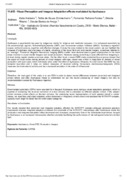Please use this identifier to cite or link to this item:
https://repositorio.ufrn.br/handle/123456789/24137| Title: | Visual Perception and Imagery Adaptation effects modulated by Ayahuasca |
| Authors: | Andrade, Katia Zimmermann, Tallita de Souza Fontes, Fernanda Palhano Ribeiro, Sidarta Tollendal Gomes Araújo, Dráulio Barros de |
| Keywords: | Ayahuasca;Visual ERP;Perception;Imagery |
| Issue Date: | Sep-2014 |
| Portuguese Abstract: | Introdução Ayahuasca is psychedelic tea used by indigenous mainly for religious and medicinal purposes. It is composed essentially by the serotoninergic agonist, N,Ndimethyltryptamine (DMT), and monoamine oxidase inhibitors (MAOi). Ayahuasca ingestion causes profound sensory, cognitive and affective changes. Among the ones related to the visual system, we can highlight the increase of brightness and sharpness of objects, vibrations of the visual field and vivid mental imagery, sometimes referred to as “seeings”. Functional Magnetic Resonance Imaging (fMRI) studies have demonstrated a great superposition in the brain areas involved in visual mental imagery and visual perception. However, seeing something is quite different from imagining it, at least during regular awake conscious states. On the other hand, a recent fMRI study conducted by our group showed that the signal of visual cortex during periods of visual imagery with eyes closed was similar in magnitude to periods of visual perception with eyes open, when individuals were under the effect of Ayahuasca. However, it is well known that fMRI has low temporal resolution and it relies on indirect measures of neuronal activity. Conversely, electroencephalography (EEG) measures the brain electric activity and has a temporal resolution in the order of milliseconds. Objetivos Therefore, the main goal of this study is to use EEG in order to detect neural differences between perceived and imagined stimuli before and after Ayahuasca intake to understand not just the neural processing of visual imagery, but also its neuromodulation caused by Ayahuasca ingestion. Métodos Eventrelated potentials (ERPs) were recorded from frequent Ayahuasca users during a visual adaptation paradigm, which is capable of evaluating the neuronal activation of a test stimulus that is preceded by different adaptor stimuli. If the adaptor stimuli produce similar effects on the test stimulus, the underlying neural representation of both adaptor stimuli is similar. Hence, we used face and object adaptors, either perceived or imagined, on test stimuli and analyzed the N170/VPP complex, typically much larger for faces than for other object categories. Resultados e Conclusões Our results showed that perceived and imagined adaptors affected the N170/VPP complex although perceived adaptors suppressed whereas imagined adaptors enhanced the amplitude of the N170/VPP. Interestingly, after Ayahuasca intake the perception and imagined adaptation effect decreased and increased, respectively. One of the remarkable experiences brought by Ayahuasca is an increased interoceptive attention probably facilitating the performance of internal against external oriented task. |
| URI: | https://repositorio.ufrn.br/jspui/handle/123456789/24137 |
| Appears in Collections: | ICe - Trabalhos apresentados em eventos |
Files in This Item:
| File | Description | Size | Format | |
|---|---|---|---|---|
| SBNeC 2014, Buzios RJ 11.015.pdf | 147,46 kB | Adobe PDF |  View/Open |
Items in DSpace are protected by copyright, with all rights reserved, unless otherwise indicated.

